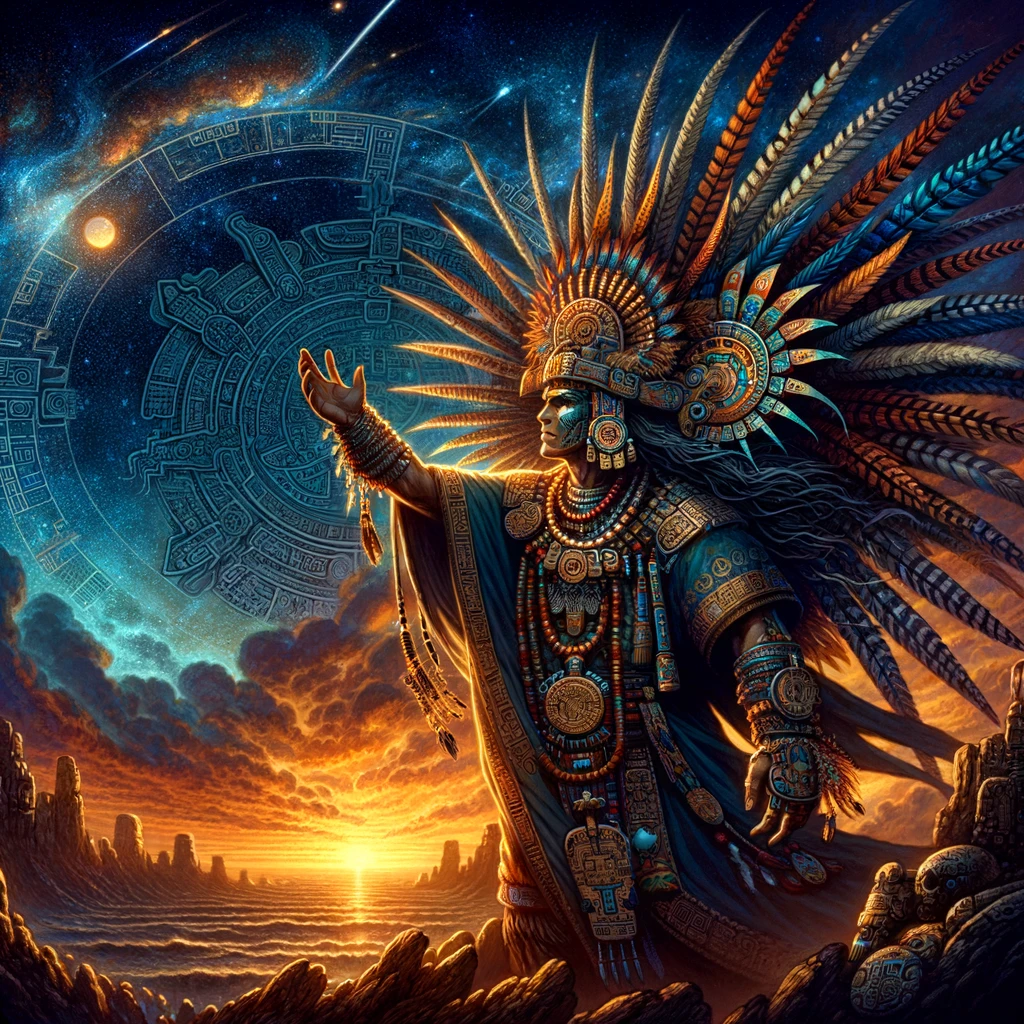
In the pantheon of Aztec deities, Tlahuizcalpantecuhtli holds a unique place as the god of the dawn, representing the morning star, often associated with the planet Venus. This deity's name, deriving from the Nahuatl language, translates to "Lord of the House of Dawn," illustrating his connection to the break of day and the celestial phenomena that herald the sun's arrival. The Aztecs, renowned for their sophisticated astronomy and deep religious beliefs, viewed Tlahuizcalpantecuhtli not just as a bringer of light but also as a harbinger of danger and an omen of conflict.
Celestial Warrior and Omen Bearer
Tlahuizcalpantecuhtli's association with the morning star made him a symbol of guidance and a warrior's protector. However, this celestial aspect also cast him as a dual-natured god, embodying both the promise of a new day and the potential for discord and destruction. His imagery often depicts him armed with arrows, ready to strike down his enemies, a metaphor for the sun's rays piercing through the darkness. This duality reflects the Aztec worldview, where creation and destruction were deeply interconnected, and gods wielded power that could both sustain and annihilate.
Mythology and Rituals
One of the most captivating myths about Tlahuizcalpantecuhtli involves his attempt to shoot the sun with arrows, an act of audacious defiance or perhaps a symbolic representation of the eternal struggle between night and day. The sun, in retaliation, strikes him down, transforming him into the stone, a tale illustrating the inevitable triumph of sunlight over darkness, but also highlighting the god's vulnerability.
Rituals dedicated to Tlahuizcalpantecuhtli were intertwined with the Aztec agricultural calendar, emphasizing his role in ensuring the cycle of growth and renewal. His appearances in the morning sky were significant events, marking times for specific ceremonies and the enactment of rituals designed to appease him, ensuring his benevolence for the crops and the people's welfare.
Astronomical Significance
The Aztecs' reverence for Tlahuizcalpantecuhtli was rooted in their advanced understanding of astronomy. They meticulously tracked the movements of Venus, recognizing its phases and its importance as a celestial marker. The morning appearance of Venus heralded by Tlahuizcalpantecuhtli was especially significant, symbolizing renewal and the cyclical nature of time. This astronomical knowledge was not merely academic; it was a vital part of their religious and agricultural practices, dictating planting and harvesting times and integrating their understanding of the cosmos with their spiritual beliefs.
Legacy and Interpretation
Today, Tlahuizcalpantecuhtli's legacy continues to fascinate scholars, historians, and enthusiasts of Mesoamerican cultures. His story and symbolism offer insights into the Aztec worldview, a civilization that combined complex astronomical observations with a deep religious fervor. The deity's role as both a harbinger of dawn and an omen of conflict serves as a reminder of the dual aspects of existence, where light and darkness, creation and destruction, are inextricably linked.
As we delve into the mysteries of the Aztec deities like Tlahuizcalpantecuhtli, we uncover layers of meaning that transcend time, reflecting universal themes of renewal, conflict, and the eternal cycle of life and death. The study of such deities not only enriches our understanding of the past but also offers a mirror to our own world, reminding us of the enduring power of myth and the stars in shaping human destiny.
Celestial Warrior and Omen Bearer
Tlahuizcalpantecuhtli's association with the morning star made him a symbol of guidance and a warrior's protector. However, this celestial aspect also cast him as a dual-natured god, embodying both the promise of a new day and the potential for discord and destruction. His imagery often depicts him armed with arrows, ready to strike down his enemies, a metaphor for the sun's rays piercing through the darkness. This duality reflects the Aztec worldview, where creation and destruction were deeply interconnected, and gods wielded power that could both sustain and annihilate.
Mythology and Rituals
One of the most captivating myths about Tlahuizcalpantecuhtli involves his attempt to shoot the sun with arrows, an act of audacious defiance or perhaps a symbolic representation of the eternal struggle between night and day. The sun, in retaliation, strikes him down, transforming him into the stone, a tale illustrating the inevitable triumph of sunlight over darkness, but also highlighting the god's vulnerability.
Rituals dedicated to Tlahuizcalpantecuhtli were intertwined with the Aztec agricultural calendar, emphasizing his role in ensuring the cycle of growth and renewal. His appearances in the morning sky were significant events, marking times for specific ceremonies and the enactment of rituals designed to appease him, ensuring his benevolence for the crops and the people's welfare.
Astronomical Significance
The Aztecs' reverence for Tlahuizcalpantecuhtli was rooted in their advanced understanding of astronomy. They meticulously tracked the movements of Venus, recognizing its phases and its importance as a celestial marker. The morning appearance of Venus heralded by Tlahuizcalpantecuhtli was especially significant, symbolizing renewal and the cyclical nature of time. This astronomical knowledge was not merely academic; it was a vital part of their religious and agricultural practices, dictating planting and harvesting times and integrating their understanding of the cosmos with their spiritual beliefs.
Legacy and Interpretation
Today, Tlahuizcalpantecuhtli's legacy continues to fascinate scholars, historians, and enthusiasts of Mesoamerican cultures. His story and symbolism offer insights into the Aztec worldview, a civilization that combined complex astronomical observations with a deep religious fervor. The deity's role as both a harbinger of dawn and an omen of conflict serves as a reminder of the dual aspects of existence, where light and darkness, creation and destruction, are inextricably linked.
As we delve into the mysteries of the Aztec deities like Tlahuizcalpantecuhtli, we uncover layers of meaning that transcend time, reflecting universal themes of renewal, conflict, and the eternal cycle of life and death. The study of such deities not only enriches our understanding of the past but also offers a mirror to our own world, reminding us of the enduring power of myth and the stars in shaping human destiny.